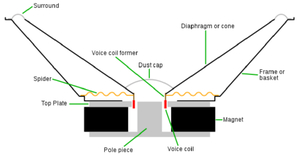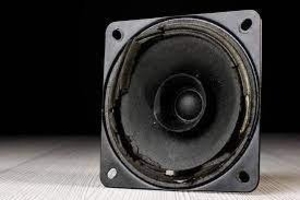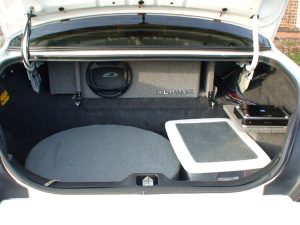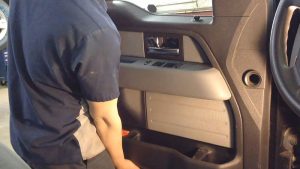Yes, subwoofers can be repaired. As a car audio enthusiast, I’ve encountered various subwoofer issues, from blown voice coils to damaged cones. Instead of replacing my subwoofer every time something went wrong, I took the time to learn how to repair them. This not only saved me money but also deepened my appreciation and understanding of my car audio system. In this comprehensive guide, I’ll share my experiences and tips on repairing car subwoofers, helping you get the most out of your audio equipment.
Contents
Common Issues with Car Subwoofers
Subwoofers are designed to withstand intense vibrations and power, but they’re not indestructible. Over time, several common problems can arise:
- Blown Subwoofer: A blown subwoofer is often the result of excessive power or distortion, which can burn out or damage the voice coil.
- Damaged Cone or Surround: Physical damage to the cone or its surrounding edge (the surround) can severely impact sound quality and performance.
- Faulty Amplifier: Sometimes, the subwoofer isn’t the problem; instead, it’s the amplifier that’s malfunctioning.
- Connectivity Issues: Loose or faulty wiring can cause intermittent sound issues or complete subwoofer failure.
- Overheating: Prolonged use at high volumes can lead to overheating, potentially damaging the subwoofer’s internal components.
Diagnosing Subwoofer Problems
Accurate diagnosis is crucial before attempting any repairs. Here’s how to pinpoint the problem:

- Visual Inspection: Start with a visual inspection to check for obvious signs of damage to the cone, surround, and wiring. Look for tears, burns, or loose connections.
- Sound Check: Play music through your subwoofer and listen for any distortion, rattling, or complete absence of sound. Each of these symptoms can indicate a different issue.
- Testing with a Multimeter: Use a multimeter to measure the resistance of the voice coil. A healthy subwoofer typically shows a resistance close to its rated impedance (e.g., 4 ohms). Significant deviations from this value can indicate a problem.
Tools and Materials Needed for Subwoofer Repair
Having the right tools and materials makes the repair process smoother and more effective. Here’s what you’ll need:
- Basic Tools: Screwdriver set, multimeter, and a soldering iron.
- Specific Materials: Replacement voice coil, cone, surround, glue, and wires.
Step-by-Step Guide to Repairing a Car Subwoofer
Here’s a detailed guide to help you repair your subwoofer:
- Replacing the Voice Coil:
- Disassemble the Subwoofer: Carefully remove the screws and separate the parts of the subwoofer.
- Remove the Damaged Voice Coil: Desolder the connections of the old, damaged voice coil and carefully remove it from the subwoofer.
- Install the New Voice Coil: Place the new voice coil in position and solder the connections securely. Make sure the coil is centered and not touching other parts to avoid short circuits.
- Reassemble the Subwoofer: Put the subwoofer back together, ensuring all parts are aligned correctly and screws are tightened.
- Repairing or Replacing the Cone and Surround:
- Detach the Damaged Components: Gently remove the damaged cone or surround from the subwoofer’s frame. Be careful not to damage other components.
- Clean the Frame: Ensure the frame is clean and free from debris to provide a good surface for the new parts.
- Attach the New Cone or Surround: Use appropriate glue to attach the new cone or surround. Allow sufficient drying time to ensure a strong bond.
- Reassemble and Test: After the glue has dried, reassemble the subwoofer and test it to ensure the repair was successful.
- Fixing Wiring Issues:
- Inspect All Wiring: Check for any loose connections or damaged wires.
- Re-solder or Replace Wires: If you find any faulty wiring, re-solder the connections or replace the wires as necessary.
- Secure Connections: Ensure all connections are tight and properly insulated to prevent short circuits.
- Testing and Reassembling the Subwoofer:
- Test the Subwoofer: Before fully reassembling, test the subwoofer to confirm that the repair was successful and that it’s producing sound as expected.
- Reassemble the Subwoofer: Once confirmed, carefully reassemble the subwoofer, ensuring all screws and components are securely in place.
Tips for Preventing Future Subwoofer Damage
To prolong the life of your subwoofer and avoid future repairs, consider these preventative measures:
- Proper Installation and Setup: Ensure your subwoofer and amplifier are correctly matched and properly installed. This includes securing the subwoofer to prevent movement and ensuring good ventilation.
- Avoid Excessive Volume and Bass Levels: Keeping the volume and bass levels within the subwoofer’s specifications helps prevent overloading and damage.
- Regular Maintenance Checks: Periodically inspect your subwoofer and its components for signs of wear or damage. Early detection can prevent minor issues from becoming major problems.
When to Seek Professional Help
Sometimes, DIY repairs might not be feasible or advisable. Here are situations where seeking professional help is the best option:
- Extensive Damage: If the subwoofer has significant damage, such as a completely burnt voice coil or heavily damaged cone, professional repair might be necessary.
- Lack of Tools or Skills: If you don’t have the necessary tools or aren’t confident in your repair skills, it’s safer to have a professional handle the repair.
- Cost Considerations: Sometimes, the cost of repair parts can be high. Compare the cost of repair with the price of a new subwoofer to decide the best course of action.
When choosing a repair service, look for reputable providers with positive reviews. Check if they offer warranties on their repairs, and always compare prices to ensure you’re getting a fair deal.
Conclusion
Repairing a car subwoofer is not only possible but often practical. By understanding common issues, accurately diagnosing problems, and following proper repair procedures, you can extend the life of your subwoofer and save money. Whether you decide to tackle repairs yourself or seek professional help, maintaining your car audio equipment ensures you continue to enjoy high-quality sound on every drive.
In my experience, learning to repair my subwoofers has been incredibly rewarding. It’s given me greater control over my car audio system and has turned potential frustrations into opportunities for learning and improvement. I encourage you to give it a try, armed with the knowledge and tips provided in this article. Happy repairing, and enjoy the bass!






